Automotive Lens with Optical and Transparent Case Study
With technical expertise and skilled hand polishing, WayKen produces automotive lenses with high optical transparency.
At a Glance of the Project
SK Design is a start-up design company formed by a group of passionate and experienced engineers in the UK. They provide professional engineering design services for various industries (industrial equipment, medical, automotive, etc.). Recently, they have designed a new car lens and want to find a professional manufacturing company to turn their ideas into reality.
| Information | |
|---|---|
| Industry | Design and customer service |
| Product | Car Lens |
| Challenges | Disassembly, gluing, and polishing |
| Technology | CNC milling, high polish |
| Material | Transparent PMMA |
| Surface finish | Deburring, optical polishing |
| Quantity | 5 units |
| Lead Time | 8 business days |
About the Product
Since this automotive lens is for lighting, it needs a very high optical transparency effect and must ensure all components assembly is successful. Transparent PC or PMMA are possible materials for lighting lenses. But how to choose the most suitable one?
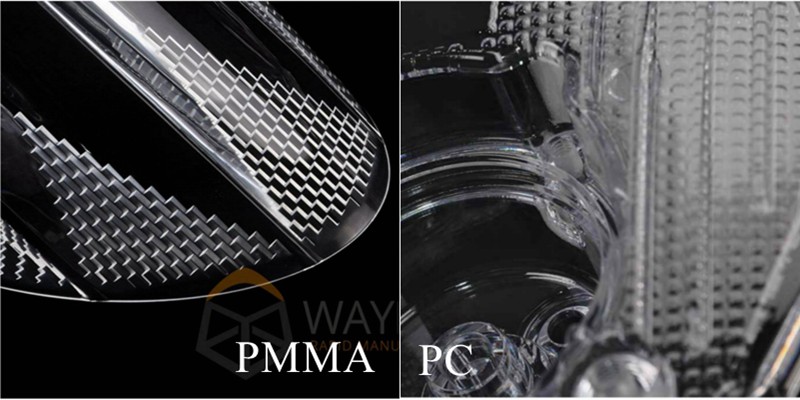
WayKen Helps Confirm the Final Material with the Customer
In the traditional industry of automotive industry, most car lens made of transparent PC. But at the stage of prototype testing, we recommended using PMMA out of the following consideration:
1. PC is an amorphous thermoplastic material, it is easily deformed during processing. Relatively, the dimensional stability of PMMA material after processing will be much better than that of PC.
2. PC material will have occurred obvious bonding marks after fumigation. After the PMMA material is disassembled and bonded, the mark is not obvious.
3. Compared to PMMA material, PC is softer in hardness, so it is easy to wear off the fine structure if the strength is not well controlled in polishing.
Processing Priorities Analysis for the Automotive Lens
1. Complex Structure and Large Overall Size
The design principle of the car lens is to consider the assembly relationship on both sides and the wide light source field of view. So in general, the outer lens’ designed angle is mostly 30-45 degrees, which makes the structure and shape of the car lens complex.
In addition, the size of the lens is large, which leads to the need for very thick materials for the overall processing. As the below picture shows, it is at least 215mm thick materials required. Commonly, transparent materials with a thickness of more than 150 mm are not in stock and need to be customized. So it will take a long time and expensive.
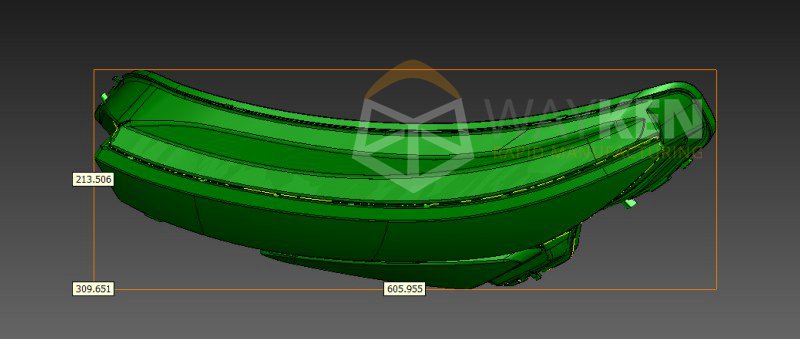
2. Dismantled Parts
The car lens is mostly designed with a deep cavity structure, which leads to a lot of cutting during processing. However, excessive removal of material will lead to the deformation of the part. In addition, it is necessary to clamp and lengthen the tool in processing. After processing will leave a large R angle (pointed by the arrow). Therefore, to avoid these problems, the machining method of dismantling generally will be used.
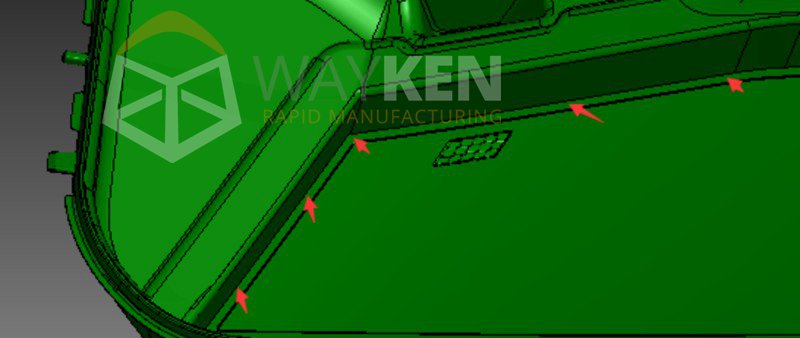
3. Small Structural Features
The small structural features in the car lens need to be processed with a small tool to restore the original design of the customer as much as possible. Usually, we will process the corner to R0.25mm or even R0.15mm, as shown in the picture below (red circle area). This is a test of the rationality of the machining tool path of CNC programming, and the stability of CNC machines.
In addition, these fine features of the car lens need to be polished without grinding. It will require a high surface finish processed by CNC. Usually, the surface roughness after polishing can reach Ra0.02.
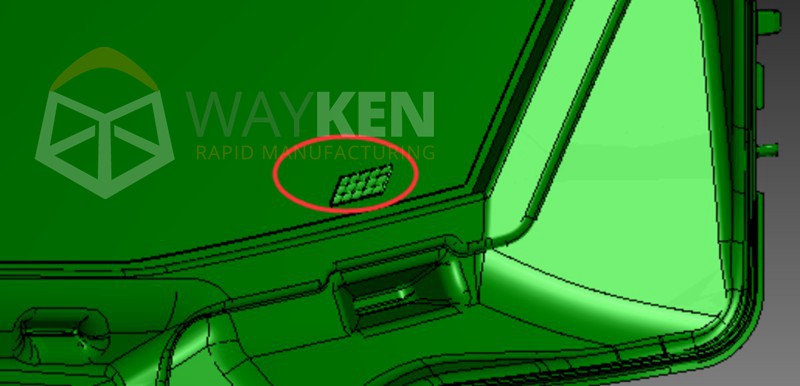
Reliable Machining Technologies and Solutions to Achieve Perfect Results
A reasonable machining strategy can effectively solve the problems of difficult to process complex structures and material limitations. As WayKen did.
Optimized Dismantled Parts Strategy
In this car lens case, we won’t disassemble the optical surface of the large transparent surface (in the picture, the yellow surface of this part is not disassembled), but disassemble the parts at the edge of the contour. So it solves structural problems and material restrictions. In this machining method, we disassembled the car lens as follows, disassembled the part into 13 individual small parts, and used CNC machining technology to machine each part separately.
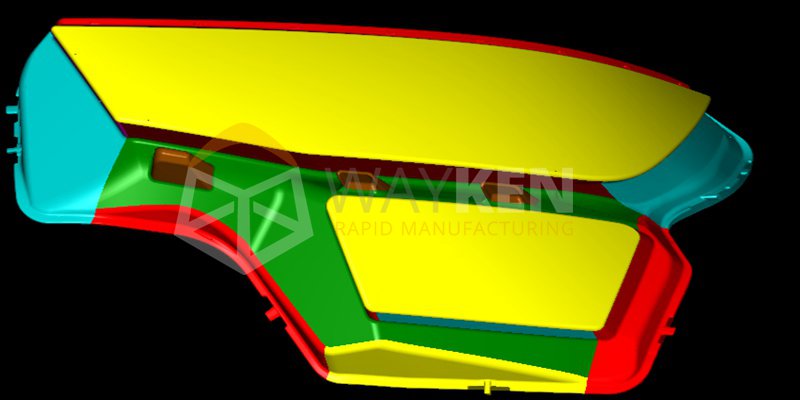
Get High Optical Polished Finishes with Hand Polishing
After processing all components of the car lens, there are two essential steps to achieve optical effects.
It is not an easy job to achieve RA0.2 optical effects. It must consider two aspects, one is that the gluing of the parts must be firmly bonded, without obvious gaps, uv marks, bubbles, and other appearance defects. The other aspect is that after gluing, the scattered parts are already whole pieces, but the surface of the car lens will still have tool marks out of the CNC machining. So it still needs to be deburred and polished.
To achieve a high optical effect for this PMMA car lens part, we developed a polishing plan for the following:
First, roughening the surface with different sandpapers, including 360# to 1500# sandpaper. After five steps of manual roughening, it can remove the tool marks on the PMMA surface. Finally, use polishing wax to remove the traces of sandpaper to achieve mirror and optical effects.
For this project, all procedures of gluing, sanding, and polishing can only be done by manual masters with years of technical experience. The high-quality handicraft piece can’t see the bonding traces on the surface and has clear optical transparency. This is an effect that is difficult to achieve with machines.
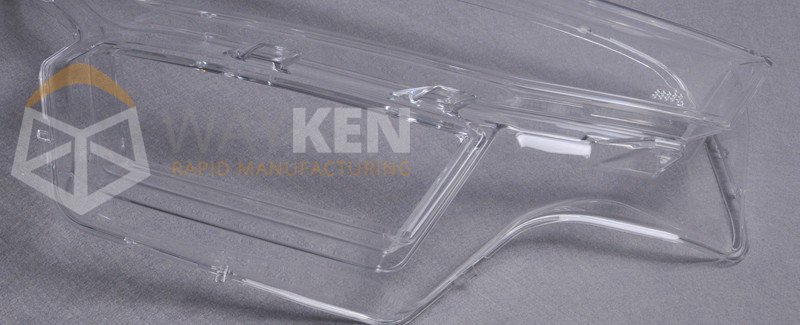
Feedback
When engineer Hasson received the product, he said “I am very impressed by your machining technology and handmade skills. Whether it is gluing or polishing, the car lens looks amazing.”
WayKen truly believes in the importance of innovation and technologies in overcoming challenges during processing. Our one-stop services combine both technological expertise and skilled manual labor to achieve outstanding results, especially when dealing with complex structures and material limitations.
If you have any machining questions for your projects, feel free to contact WayKen to discuss your ideas.





